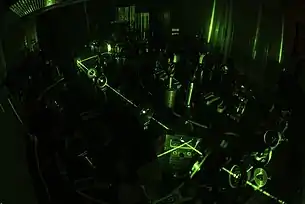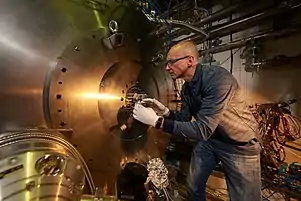| ELENA | Extra low energy antiproton ring – further decelerates antiprotons coming from AD |
|---|---|
| AD experiments | |
| ATHENA | AD-1 Antihydrogen production and precision experiments |
| ATRAP | AD-2 Cold antihydrogen for precise laser spectroscopy |
| ASACUSA | AD-3 Atomic spectroscopy and collisions with antiprotons |
| ACE | AD-4 Antiproton cell experiment |
| ALPHA | AD-5 Antihydrogen laser physics apparatus |
| AEgIS | AD-6 Antihydrogen experiment gravity interferometry spectroscopy |
| GBAR | AD-7 Gravitational behaviour of anti-hydrogen at rest |
| BASE | AD-8 Baryon antibaryon symmetry experiment |
| PUMA | AD-9 Antiproton unstable matter annihilation |
AEgIS (Antimatter Experiment: gravity, Interferometry, Spectroscopy), AD-6, is an experiment at the Antiproton Decelerator facility at CERN. Its primary goal is to measure directly the effect of Earth's gravitational field on antihydrogen atoms with significant precision.[1] Indirect bounds that assume the validity of, for example, the universality of free fall, the Weak Equivalence Principle or CPT symmetry also in the case of antimatter constrain an anomalous gravitational behavior to a level where only precision measurements can provide answers. Vice versa, antimatter experiments with sufficient precision are essential to validate these fundamental assumptions. AEgIS was originally proposed in 2007.[2] Construction of the main apparatus was completed in 2012. Since 2014, two laser systems with tunable wavelengths (few picometer precision) and synchronized to the nanosecond for specific atomic excitation have been successfully commissioned.[3]
AEgIS experimental setup and physics

AEgIS will attempt to determine if gravity affects antimatter in the same way it affects normal matter by testing its effect on an antihydrogen beam. The aspired experimental setup uses the Moiré deflectometer to measure the vertical displacement of a beam of cold antihydrogen atoms traveling in Earth’s gravitational field.[4]
In the first phase of the experiment (running until 2018), antiprotons from the Antiproton Decelerator (AD) with a kinetic energy of 5.3MeV had to pass through a series of aluminum foils which acted as so-called degraders, slowing down a fraction of the fast antiprotons to few keV. The slow antiprotons were then further cooled by merging them with extra cold trapped electrons (electron cooling) and finally trapped inside a Malmberg–Penning trap.[5] An intense radioactive β+ source (22Na) was used to produce positrons, which were accumulated in a Surko-type storage trap at low pressure (3e-8 mbar). These positrons were implanted into a nano-structured porous silicon target in order to efficiently form positronium (Ps) - even at cryogenic temperatures in Ultra-high vacuum (UHV).[6] A cloud of positronium emerging from the target was then excited to a Rydberg level of n=16/17 by using laser-induced two-step optical transitions.[3] Inside the Malmberg–Penning trap, the charge exchange reaction between cold antiprotons and Rydberg-Ps took place, leading to the formation of Rydberg-antihydrogen with high efficiency in the form of a 4π pulse.[7][8]
(Charge exchange reaction)
This paragraph is woefully out of date. It appears to have been written in 2014, nine year ago. In the 27 October 2023 issue of Nature they published the result that antihydrogen falls. Gravity attracts it in the same way it attracts hydrogen. What follows needs to be updated. In the second phase of the experiment, starting from 2021 after AEgIS has been successfully connected to the new antiproton deceleration and storage ring ELENA, the Rydberg antihydrogen atoms will be channeled into a beam, which then will pass through a series of matter gratings, the central piece of a Moiré-deflectometer. The antihydrogen atoms will ultimately hit onto the surface of a position and time-resolving detector, where they will annihilate. Areas behind the gratings are shadowed, while those behind the slits are not. The annihilation locations reproduce a periodic pattern of light and shadowed areas. This pattern is highly sensitive to small vertical displacements of the anti-atoms during their horizontal flight - the Earth's gravitational force on antihydrogen can thus be determined.[4]
AEgIS collaboration


The AEgIS collaboration comprises the following institutions:
- University of Bergen, Norway
- Warsaw University of Technology, Poland
- Raman Research Institute, India
- Polish Academy of Sciences, Poland
- Nikolaus-Kopernikus-Universität Toruń, Poland
- INFN, Italy
- University of Liverpool, United Kingdom
- University of Oslo, Norway
- Czech Technical University in Prague, Czech Republic
- Université de Lyon, France
- University of Latvia, Latvia
- University of Trento, Italy
- Politecnico Milano, Italy
- CERN, CERN
See also
- Antiproton Decelerator
- GBAR experiment
- ALPHA-g experiment
References
[1] [2] [5] [4] [3] [8] [6] [7]
- 1 2 Doser, M. (2022). Status report for the AEgIS experiment for 2021 (PDF). Status Report. CERN. Geneva. SPS and PS Experiments Committee, SPSC.
- 1 2 Drobychev, G.Yu; Doser, M.; et, al. (2007). Proposal for the AEGIS experiment at the CERN antiproton decelerator (Antimatter Experiment: Gravity, Interferometry, Spectroscopy). CERN. Geneva. SPS Experiments Committee, SPSC.
- 1 2 3 Aghion, S.; et, al. (AEgIS Collaboration) (July 2016). "Laser excitation of the n=3 level of positronium for antihydrogen production". Physical Review A. 94: 012507. doi:10.1103/PhysRevA.94.012507. hdl:11311/1007035.
- 1 2 3 Aghion, S.; Ahlén, O.; Amsler, C.; et, al.(AEgIS Collaboration) (July 2014). "A moiré deflectometer for antimatter". Nature Communications. 5: 4538. doi:10.1038/ncomms5538. PMC 4124857. PMID 25066810.
- 1 2 Tietje, I.C.; et, al. (August 2020). "Protocol for pulsed antihydrogen production in the AEgIS apparatus". Journal of Physics: Conference Series. 1612: 012025. doi:10.1088/1742-6596/1612/1/012025. S2CID 225388648.
- 1 2 Mariazzi, S.; et, al. (AEgIS Collaboration) (May 2021). "High-yield thermalized positronium at room temperature emitted by morphologically tuned nanochanneled silicon targets". Journal of Physics B: Atomic, Molecular and Optical Physics. 54 (8): 085004. doi:10.1088/1361-6455/abf6b6. hdl:10852/92391. S2CID 234865124.
- 1 2 Antonello, M.; et, al. (AEgIS Collaboration) (July 2020). "Rydberg-positronium velocity and self-ionization studies in a 1T magnetic field and cryogenic environment". Physical Review A. 102: 013101. arXiv:1911.04342. doi:10.1103/PhysRevA.102.013101. S2CID 207853146.
- 1 2 Amsler, C.; Antonello, M.; Belov, A.; et, al. (AEgIS Collaboration) (February 2021). "Pulsed production of antihydrogen". Communications Physics. 4: 19. doi:10.1038/s42005-020-00494-z. hdl:10852/92284. S2CID 231858825.